
Ural Motorcycles—official name IMZ-Ural Group Inc., Russian: Мотоциклы Урал; Romanized: Motosikly Ural—is a multinational company involved in developing, manufacturing, and worldwide distribution of Ural sidecar motorcycles. Headquartered in Redmond, Washington, with assembly facilities in Petropavl, Kazakhstan, Ural is the oldest and one of the world's largest manufacturers of sidecar-equipped motorcycles.
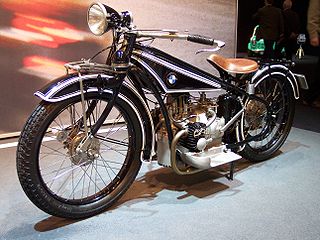
BMW's motorcycle history began in 1921 when the company commenced manufacturing engines for other companies. BMW's own motorcycles—sold under the BMW Motorrad brand—began in 1923 with the BMW R 32, which was powered by a flat-twin engine. Production of motorcycles with flat-twin engines continues to this day, however BMW has also produced many models with other types of engines.

Dnepr is a motorcycle brand produced in Kyiv, Ukraine. It has been in use since 1967.
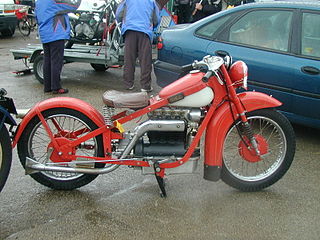
The Nimbus is a Danish motorcycle produced from 1919 to 1960 by Fisker and Nielsen of Copenhagen, Denmark, also manufacturers of "Nilfisk" brand vacuum cleaners. Two basic models were produced, both with a 750 cc four-cylinder engine.

Zündapp was a major German motorcycle manufacturer founded in 1917 in Nuremberg by Fritz Neumeyer, together with the Friedrich Krupp AG and the machine tool manufacturer Thiel under the name "Zünder- und Apparatebau G.m.b.H." as a producer of detonators. In 1919, as the demand for weapons parts declined after World War I, Neumeyer became the sole proprietor of the company, and two years later he diversified into the construction of motorcycles.

A motorcycle engine is an engine that powers a motorcycle. Motorcycle engines are typically two-stroke or four-stroke internal combustion engines, but other engine types, such as Wankels and electric motors, have been used.
The Automobilwerk Eisenach (AWE) was an automobile manufacturer in Eisenach, Germany.

Chang Jiang is the transcribed brand name of motorcycles that were once manufactured by the China Nanchang Aircraft Manufacturing Company. It takes its name from the Chang Jiang River, also known as the Yangtze or, in English, the Long River.

The Harley-Davidson WLA is a Harley-Davidson motorcycle that was produced to US Army specifications in the years during and around World War II. It was based on an existing civilian model, the WL, and is of the 45 solo type, so called due to its 45-cubic-inch (740 cm3) engine displacement and single-rider design. It acquired the nickname "Liberator".
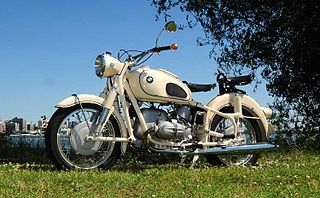
The R69S, R69US, and R69 are motorcycles, fitted with 594 cc boxer twin engines, that were manufactured by BMW in Munich, Germany.

For the WWII-era motorcycle, see BMW R75
The history of the motorcycle begins in the second half of the 19th century. Motorcycles are descended from the "safety bicycle," a bicycle with front and rear wheels of the same size and a pedal crank mechanism to drive the rear wheel. Despite some early landmarks in its development, the motorcycle lacks a rigid pedigree that can be traced back to a single idea or machine. Instead, the idea seems to have occurred to numerous engineers and inventors around Europe at around the same time.

The Harley-Davidson XA was a flat-twin, shaft drive motorcycle made by Harley-Davidson for the US Army during World War II.

Rikuo Internal Combustion Company was one of the first motorcycle manufacturing companies in Japan. In the early 1930s Rikuo operated under the license and name of Harley-Davidson, using their tooling, and later under the name Rikuo until 1958. Harley-Davidson themselves did not publicize this Japanese connection because the Japanese were helped in developing mass-production techniques by the introduction of this factory into Japan just prior to the Second World War. The Society of Automotive Engineers of Japan(in Japanese) rates the 1935 Rikuoh Large Motorcycle as one of their 240 Landmarks of Japanese Automotive Technology.
BMW Motorrad is the motorcycle brand and division of German automotive manufacturer, BMW. It has produced motorcycles since 1923, and achieved record sales for the fifth year in succession in 2015. With a total of 136,963 vehicles sold in 2015, BMW registered a growth of 10.9% in sales in comparison with 2014. In May 2011, the 2,000,000th motorcycle produced by BMW Motorrad was an R1200GS.

Sanglas was a Spanish motorcycle manufacturer which was founded in Barcelona in 1942 and ceased production in 1981.
The FN M12 was a motorcycle manufactured from 1937 to 1940 by the Belgian company Fabrique Nationale de Herstal, primarily for use with a sidecar. 1,180 were built, 1,090 of which were delivered to the Belgian military as heavy sidecar combinations.
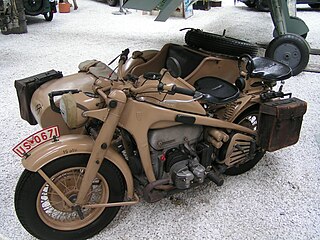
The Zündapp KS 750 is a World War II-era motorcycle and sidecar combination developed for the German Wehrmacht before and during the Second World War, by the German company Zündapp G.m.b.H. After entering service in 1941, over 18,000 were built through 1944, and deployed on all major German battlefronts, for use in a variety of roles. The KS 750 was an integral design, featuring not one but two driven wheels – both the rear wheel and the sidecar wheel were shaft driven, powered by a 751 cc (45.8 cu in), overhead valve, flat twin engine.
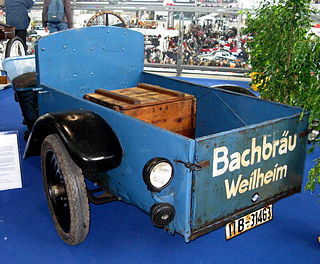
The BMW F 76 was a small tricycle delivery van made by BMW. It was built from 1932 to 1933 in BMW's Eisenach plant. In 1933, the BMW F 79 version with a larger engine was put into production.
















